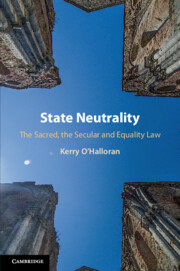Book contents
- State Neutrality
- State Neutrality
- Copyright page
- Dedication
- Contents
- Acknowledgements
- Introduction
- Part I Background
- Part II The Benchmark of State Neutrality
- 4 The United States of America: The Church–State Wall
- 5 Canada: Bijuralism
- 6 England: The Established Church
- 7 France: Laïcité
- 8 Germany: The Vaterland
- 9 Israel: Halakha and Zionism
- Part III Towards a More Stable Civil Society
- Conclusion
- Index
6 - England: The Established Church
from Part II - The Benchmark of State Neutrality
Published online by Cambridge University Press: 15 January 2021
- State Neutrality
- State Neutrality
- Copyright page
- Dedication
- Contents
- Acknowledgements
- Introduction
- Part I Background
- Part II The Benchmark of State Neutrality
- 4 The United States of America: The Church–State Wall
- 5 Canada: Bijuralism
- 6 England: The Established Church
- 7 France: Laïcité
- 8 Germany: The Vaterland
- 9 Israel: Halakha and Zionism
- Part III Towards a More Stable Civil Society
- Conclusion
- Index
Summary
Begins with an overview of policy development in relation to religion and the church–state relationship, giving specific attention to the disjunctive concepts of “state neutrality” and an “established church” and to policies for promoting civil society. It then outlines the relevant legal framework before exploring the nature of the current church–state relationship, explaining definitional matters and focusing on the core freedoms of religion, association and expression. This leads into the heart of the chapter, which considers the impact of equality legislation on the church–state relationship, as illustrated in evolving case law, by examining in turn the consequences for family and life, healthcare, education, employment, service provision and national security.
- Type
- Chapter
- Information
- State NeutralityThe Sacred, the Secular and Equality Law, pp. 250 - 307Publisher: Cambridge University PressPrint publication year: 2021

